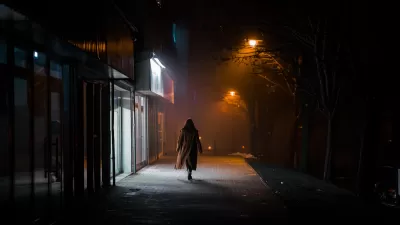The increase in vehicular speeds, removal of street hawkers, and addition of gated neighborhoods are all seen as contributing to a rise in crimes against women in New Delhi and other Indian cities. How can planning and design reverse this trend?
Neyaz Farooqui looks at some of the factors that are thought to have contributed to the rise in sexual violence in India's cities. Auto-centric planning, the placement of streetlights, and the segregation of cities into zones of exclusion each have a role in producing unsafe social and physical environments for women.
"Urban planners and designers argue that apart from better policing, gender-sensitive city planning and design can help make India’s cities safer for women," explains Farooqui. "Patterns of crime in a city, according to these experts, vary according to its urban design."
UPDATE (9/30): It appears as though some cities are already taking steps to create women-only spaces in response to the rise in sexual violence. Writing in The Washington Post, Annie Gowen notes that women-only buses, cabs, travel groups, and parks are emerging in several cities.
FULL STORY: Can Urban Planning Help India’s Cities Reduce Sexual Violence ?

Planetizen Federal Action Tracker
A weekly monitor of how Trump’s orders and actions are impacting planners and planning in America.

Maui's Vacation Rental Debate Turns Ugly
Verbal attacks, misinformation campaigns and fistfights plague a high-stakes debate to convert thousands of vacation rentals into long-term housing.

Restaurant Patios Were a Pandemic Win — Why Were They so Hard to Keep?
Social distancing requirements and changes in travel patterns prompted cities to pilot new uses for street and sidewalk space. Then it got complicated.

In California Battle of Housing vs. Environment, Housing Just Won
A new state law significantly limits the power of CEQA, an environmental review law that served as a powerful tool for blocking new development.

Boulder Eliminates Parking Minimums Citywide
Officials estimate the cost of building a single underground parking space at up to $100,000.

Orange County, Florida Adopts Largest US “Sprawl Repair” Code
The ‘Orange Code’ seeks to rectify decades of sprawl-inducing, car-oriented development.
Urban Design for Planners 1: Software Tools
This six-course series explores essential urban design concepts using open source software and equips planners with the tools they need to participate fully in the urban design process.
Planning for Universal Design
Learn the tools for implementing Universal Design in planning regulations.
Heyer Gruel & Associates PA
JM Goldson LLC
Custer County Colorado
City of Camden Redevelopment Agency
City of Astoria
Transportation Research & Education Center (TREC) at Portland State University
Jefferson Parish Government
Camden Redevelopment Agency
City of Claremont





























